History of Richmond Rowing Club
Regattas
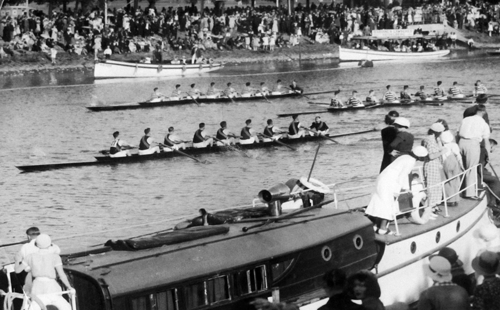
Regatta 1932 Henley: 1 Richmond, 2: Hawthorn, 3 Footscray
The first Melbourne Amateur Regatta, conducted on the Yarra River for sweep oared rowing was held in 1860 and continued until 1903.
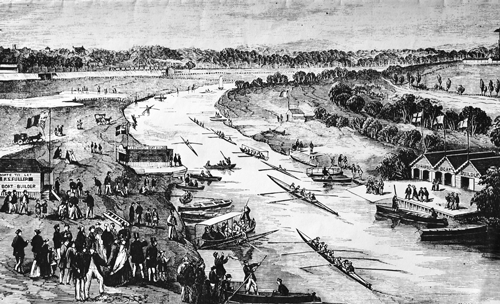
1867 The Yarra Easter Monday (looking upstream from Princes Bridge)
In October 1863, the newly formed Richmond Rowing Club was organising the Melbourne Annual Regatta of 1863. The organising committee collected over £150 for prizes and the regatta was to take place on Monday 9th November 1863 on the Saltwater River, now known as Maribyrnong River. The day was a holiday to celebrate the Prince of Wales birthday. It was estimated that between 4,000 and 8,000 spectators attended the regatta.
A Richmond crew won the Ladies Plate, and the win was described as Richmond's star was in ascendant'. Richmond crews also won the Footscray Plate and the Junior 4 Oared Gig and their club uniform was reported as green and amber.
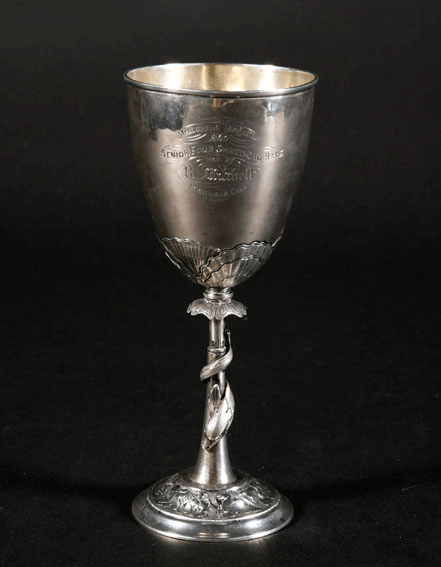
1869 Melbourne Regatta Cup - R Mitchell
Entries for the regattas were promoted in notices of the newspapers, both daily and weekly, with details of when and where entries were to be taken. These often took place in the hotels in the inner city area. Results of rowing regattas were also widely reported in the papers of the day. The reports would list the crews who competed and include seat position and weight of the person, or the average weight of the crew.
Notices were also published of when and where the presentation of trophies was to be held, usually a week after the regatta, and again in hotels, as the clubs did not yet have facilities for anything but storage of boats and equipment.
Richmond City Regatta
Established to celebrate Richmond being proclaimed a city, the Richmond City regatta first took place on Saturday 9th December 1882. The regatta committee was made up of representatives of the Council and Richmond City Rowing Club.
The course for the regatta was the Upper Yarra between Stony Point, above Church Street Bridge, to the reserve near Punt Road Bridge, a distance of one mile. At this time the Yarra was divided into Upper Yarra and Lower Yarra, due to a large amount of rocks blocking navigation west of where Queens Bridge is now located. The programme included senior fours and sculls, maiden fours, pairs and sculls.
In 1882 the committee for the Richmond City Regatta was canvassing for the support of residents and had a "great amount of support and encouragement to provide a good days sport on 9th December ... I Richmond Australian, 25 November 1882]. Trophies and subscriptions were collected and the total value of prizes offered was over £100 for six events. The Committee trophy was described as "a handsome timepiece in gold and enamel. prettily ornamented. and a pair of vases to match ... Other trophies were described as "rich collection of trophies", and included solid silver. of chaste design and costly epergne. The committee also gave 15 valuable gold medals.
It is thought that this regatta was running until at least 1886. At this time, the regatta committee, made up of representatives of the City and the Richmond Rowing Club, recorded discussion that the rowing club wanted to run its own regatta, but could not pull off two events successfully. The newspapers of the day indicate that the Richmond Rowing Club had its own regatta operating very successfully in February 1887.
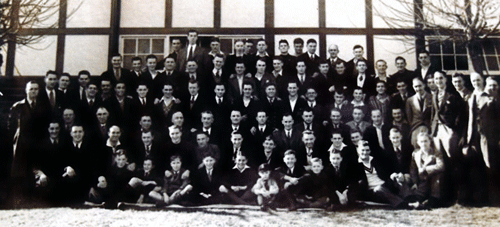
Yarra on Regatta day 1900 (note the city in the background)
October 1914, The Argus newspaper reports that Richmond Rowing Club opened the season with scratch four oar races for trophies presented by the committee. Forty-eight oarsmen competed, and some excellent racing resulted. The president [Mr Allied Wood] acted as starter, and Mr Charles Cox as judge.
Another The Argus newspaper report states that on Saturday 10th January 1925 RRC held the annual "Dimmey" pair-oared races for trophies, over a short course. Members took part in a char-a-bane picnic to Warrandyte the next day.
In March 1926 the first Richmond Rowing Club crew travelled to Launceston to compete in the Henley on Tamar. Richmond continued to travel south to Tasmania to compete in various regattas in the state until 1940.
The Australian Henley Regatta was commenced from 1904, replacing the Melbourne Amateur Regatta. and was regarded as the premier Regatta in Australia second to the Kings Cup. Richmond had crews representing the club at this significant annual competition. with many crews taking line honours.
The 1925 Henley Regatta was described as including a grand parade of canoes at the conclusion of racing. Also included in the event were the refreshment kiosks erected on the
north bank and on the south bank, dancing on the lawn with a band playing. Fireworks display was described as being 'better than anything else seen at Henley'. Mr C Mernick of the Richmond Rowing Club was appointed to broadcast descriptions of the races, and the results of all events.
Melbourne Amateur Rowing Association constructed the present staging and judges box. Decorated houseboats would line the Yarra River bank and small craft of all sorts were on the river at regattas. There would be large crowds on both banks of the Yarra and moored boats used as grandstands. Booms were laid along either side of the course for the last quarter mile, to leave clear water for the competing crews. Regattas attracted large spectator crowds, lining the banks and crowding onto boats. One reason for the high patronage on regatta days was that betting on the races was prolific.
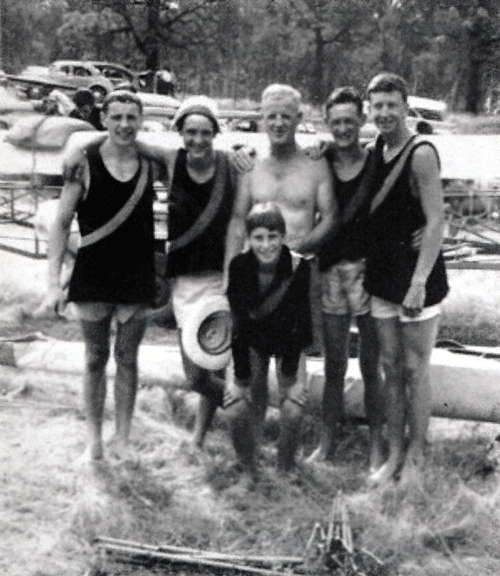
RRC Program 1887
Transport and regattas
Country and interstate regattas have been an important part of rowing competition. Before the current road transport vehicles, boats would be transported by railroad to destinations where a regatta was conducted. The boats were floated across the Yarra to the railway yards, or de-rigged and carried across Princes Bridge to the railway station. They were then loaded on to flat top rail trucks for carriage to country areas. On arrival at the country railway station, the boats were then wheeled on jinkers [horse drawn cart] to the regatta venue. Some of these regattas no longer exist, such as Horsham, Seymour, Shepparton, Lilydale Lakes and Preston [Lake Edwards).
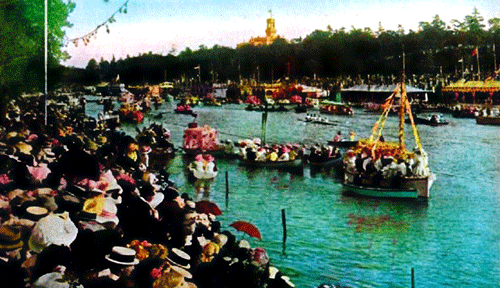
Rowing race at Henley on Yarra early 1920s (note Government House in the background
As transport methods developed and rowing clubs had access, flat bed trucks were used to get to regattas held in locations where clubs could not row boats to the event or to the country regattas. Eventually trailers, capable of moving the boats and equipment to regattas, and towed by motor cars were introduced.
Where ever possible Richmond has travelled to country regattas. This has included, over the decades, Albert Park, Bairnsdale, Ballarat, Bendigo, Dimboola, Footscray, Essendon, Hamilton, Horsham, Lilydale Lakes, Mildura-Wentworth [Easter]. Nagambie, Preston Lakes, Rutherglen, Seymour, Sale, Yarrawonga to name some. During drought some of the regattas have fallen in abeyance when the river or lake has fallen below safe levels or dried up completely.
The New Years Regatta, made up of three regattas held on Boxing Day at Nagambie, 28 December at Yarrawonga and New Year's Day at Rutherglen Lakes, was supported by Richmond. Whilst attending this series of regattas in 1985, the tow vehicle and boat trailer was involved in fire. The tow vehicle pulled over to the side of the road, where the heat from the under carriage of the trailer, caused the bone dry grass to ignite into flames, which then engulfed the trailer, destroying boats and equipment.
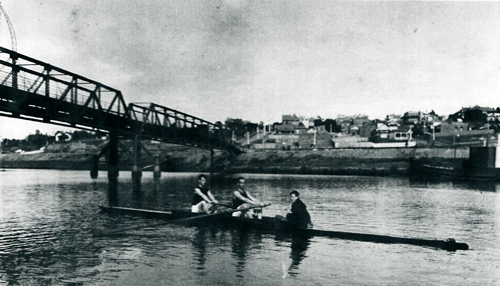
1907 Seymour Regatta RRC, winners maiden pair (showing Punt Bridge)
The club gained its own trailer in 1991 when club stalwart, Don Dudgeon, provided the 'Don built trailer.
Regattas are the opportunity for rowers to compete and test their skills against other rowers. For Richmond it has also been the chance for our unique club spirit to develop and strengthen. In 2000 the club commenced hiring buses to transport the club participants to regattas. The sight of a bus pulling up at the regatta, unloading all the club's attendees en-masse had an effect on the other clubs, who noted that it showed a great club spirit.
Richmond conducted its first regatta in over 80 years in 2000. The regatta was a great success with members frantically torn between seats in racing boats and serving cafe latte in catering tents. Crews missed races while preparing food, first time racers stood waiting for instructions from coaches, while coaches searched for crew members amongst the hundreds of school children who had turned up for their first day of their rowing season. Members over the past six decades turned up for the presentation at the conclusion of a great day.
Yea: the year we sank the boat
"The rowing course at Yea had an extremely fast current. Water flowed out from the weir upstream and screamed down the Goulburn River.
At the Yea Regatta you had to put the boat in at the finish line, do a U turn and go down the far side of the river to the start. Well one year, I was stroking the four and we were in a brand new boat. We got in and were going down to the start. We got about three boat lengths down and there was a snag in the river, just below the surface.
Well it went in below the two seat and it was like a can opener. It ripped the boat right along the bottom, all the way to stroke seat. We started to fill up with water and when I jumped over the side, it was freezing! We had to swim the boat across the river to get out again. Kevin Kost, a young boy, was our coxswain and we had to make sure he was all right. By the time we reached the other side where the people were the current had taken us about half a mile downstream, it was that quick! And when we got out we were all blue!"
Colac: how to line up an eight in a cross wind
"Lake Colac had a reputation for being full of sewerage. You had to row down to the start and turn around onto the starting line.
Well, one day it was really windy and we were in an eight and couldn't line up straight the wind was that strong. So the bowman actually got out of the boat to stand in the water and hold the boat steady.
When the gun went off he jumped back in the boat and started rowing."
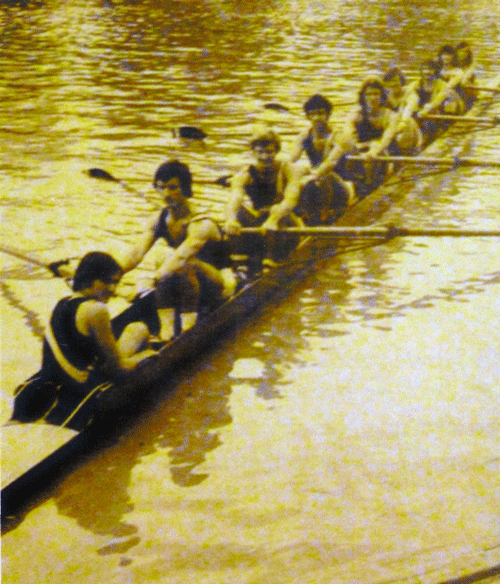
Men's Eight, 1973
Walter (Wally) Lambert
Born 1919; died 1993
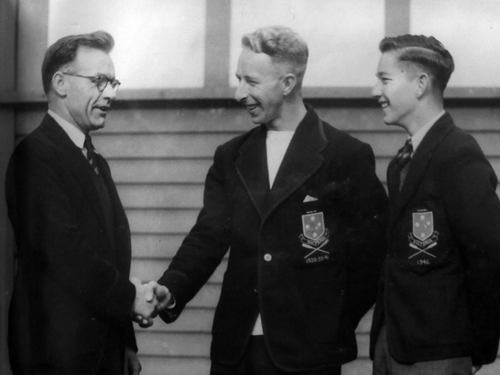
Ron March, Wally Lambert, Peter Wilding
Wally Lambert was the best of Australian talent and until 1988 was the only Australian Olympic representative. He joined RRC in 1936 as he thought he needed more exercise. He was a promising young Richmond oarsman, and stroked the 1939 King's Cup crew. In 1940 Wally won the RRC trophy for novice sculler. Wally was an outstanding stroke man who appears to have been selected solely in that seat.
After the Second World War, Wally stroked two winning King's Cup crews, achieved Olympic selection in 1948 and represented Australia on two other occasions.
Wally's greatest rowing achievement was his gold medal win, with regular partner Jack Webster (South Melbourne), in the coxless pairs at the 1950 Empire Games in new Zealand. The pair was coached by Lochie Thompson, another RRC members. From 1930-50, Wally and Jack were considered among Australia's best champion rowers.
Mt Lambert's widow, Sheila, reflected in an obituary in The Sun newspaper that her husband felt he had reached the pinnacle of his rowing career when he was awarded an Olympic blazer to participate in the 1948 London Game. 'He absolutely treasured his Olympic blazer and was so proud to have represented Australia,' Mrs Lambert said.
Wally Lambert was inducted into Rowing Victoria's Hall of Fame in 2011.

